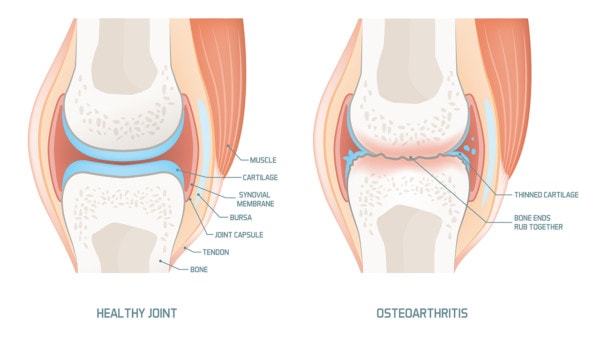Arthritis from Injury to a Joint: Can It Be Prevented?
Our entire medical-care system has been trained through decades of trying to control costs to simply ignore small injuries. However, here’s the thing: these small injuries can become big problems if left untreated. In fact, all severe arthritis likely starts with a small injury to the cartilage or ligaments that was ignored. I call these ACEs, which stands for arthritis-causing events. So which is it? Ignore the little injuries or pay attention? In my world, paying attention to the ACEs that can cause small amounts of instability could prevent an awful lot of fried joints.
Osteoarthritis Defined

Elenabsl/Shutterstock
Osteoarthritis (OA) is a progressive disease of the joints in which the cartilage, which cushions the bones and absorbs shock, wears down. Chronic pain, stiffness, and swelling are the most common symptoms (though the damaged cartilage isn’t necessarily the source of the pain), and in the most severe cases, patients can literally be left with bone on bone.
According to the CDC, over 30 million Americans suffer with OA, making it, by far, the most common type of arthritis in the U.S. While the risk for OA does increase as we age (though the paper below states that over half of knee OA patients are under the age of 65), nearly 20% (5.5 million) of Americans have arthritis from injury to a joint, or posttraumatic arthritis. For example, an 18-year-old soccer star with a joint injury, especially one who undergoes surgery, is at a high risk for developing arthritis by the age of 30.
Arthritis from injury to joints isn’t just reserved for athletes; anyone can experience a joint injury, especially if the person is at an increased risk, due to things such as obesity, repetitive stress, and even genetics.
What Is an ACE?
While our joints connect bone to bone, it’s important to understand that the joint isn’t just cartilage and bone. The joint consists of many other structures that work in harmony to provide controlled motion. These include muscles, ligaments and tendons, nerves, and, of course, the bone and cartilage. The joint is just the contact point where two parts of an interconnected musculoskeletal system come together.
An arthritis-causing event (ACE) happens when one of those structures get injured. Actual arthritis may happen much later. These include the following:
- A small area of damage to the cartilage
- Damage to the cushioning structures, like the meniscus or the labrum
- Damage to the ligaments
While we can treat all of these injuries earlier now with minimally invasive regenerative medicine procedures, today I’ll focus on the easiest to treat, which is the last one—the ligaments.
A Statement on Risk Factors for and Prevention of Arthritis from Injury to a Joint
A paper recently published in the Journal of Athletic Training highlights how small joint injuries can be magnified by all sorts of factors to grow up to be full-blown arthritis. For example, a small ding in the otherwise smooth cartilage surface can lead to the bone swelling. This can then stretch the cartilage and place more pressure at that spot, leading to a hole in the cartilage. Or a ligament injury can happen, which causes the joint to be unstable. These extra wear-and-tear forces lead to cartilage loss and bone spurs. Add in extra weight to that equation and it all goes that much quicker.
In fact, the single biggest issue we see that can be easily fixed and likely prevent arthritis is instability. A ligament at some point gets stretched, but not broken. The area swells for a couple of days, but, eventually, the ligament heals in a loose position. The joint cracks and pops a bit more, but it mostly goes unnoticed. However, one or more decades of extra motion caused by the loose ligament causes arthritis. All of this could have been prevented if:
- the patient understood that a joint injury that leads to popping and cracking in a joint, but no pain, is a potential arthritis-causing event, or
- the patient had been checked out by a physician who understands subfailure instability.
Orthopedic Surgeons Generally Don’t Understand This Type of Instability
Every year, I see scores of patients who have been told their knee is stable by an orthopedic surgeon and then I show them on stress ultrasound that the joint is unstable. Why? To an orthopedic surgeon, stability is a binary concept—the ligament is broken and needs to be fixed surgically or it’s not and it needs to be left alone. However, ligament laxity is a spectrum disorder from normally tight to loose to broken. Hence, conceptualizing it as binary is bad for patients.
The upshot? How do you know if you’ve had an instability causing ACE? Regrettably, your average orthopedic surgeon is not likely the person from whom you’ll find that out. The simplest test is a stress ultrasound, in which the doctor takes the joint and stresses it while looking at the ligaments with ultrasound to rule out too much give. If you’ve had this type of injury, a precise injection of platelet rich plasma will usually help the ligament heal and tighten and provide better stability to the joint. So in conclusion, pay attention to the little dings, they may become big issues later!

NOTE: This blog post provides general information to help the reader better understand regenerative medicine, musculoskeletal health, and related subjects. All content provided in this blog, website, or any linked materials, including text, graphics, images, patient profiles, outcomes, and information, are not intended and should not be considered or used as a substitute for medical advice, diagnosis, or treatment. Please always consult with a professional and certified healthcare provider to discuss if a treatment is right for you.
